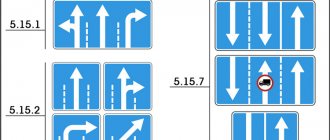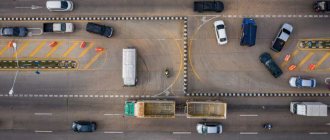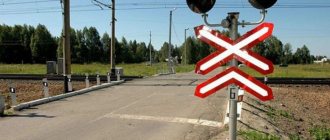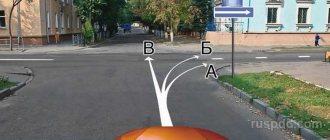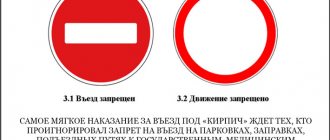What fines are preset for a no turn sign?
The extent and details of the penalty for violating the Traffic Rules are subject to the degree of danger of the action to the lives of others.
The following penalties have been developed for deviating from a turn prohibition:
- U-turn or turn within the range of the “Go straight ahead” sign - 1-1.5 tr. except for traveling to the adjacent territory.
- U-turn or turn to the left in the range of prohibitory signs - 1-1.5 tr.
- U-turn or turn to the right in the range of prohibition signs - 500 rubles.
- The owner of the car did not give way while turning - 1 t.r.
- The vehicle entered a unidirectional lane of oncoming traffic - from 5 tr. until the driver's license is withdrawn for six months.
Violation of a U-turn sign is prohibited, fine
- 4.1 What is the penalty for turning?
- 2.1 Online driving school
- 1.1 Fines for the “No Right Turn” sign
"Moving Straight"
The specified road sign allows the car owner to move exclusively in a straight direction, prohibiting the use of other maneuvering options.
If a sign is installed at a road intersection, its powers affect only this intersection. If it is placed outside an intersection, then its influence extends within the road until the nearest intersection. In this case, there is no prohibition on turning to the right if you need to get into nearby territory. Route buses, trolleybuses and trams may not be subject to this restriction.
An important note is that the sign in question may be located in a break in the demarcation strip to prevent vehicles from turning left and making a U-turn.
A serious violation is the intentional or unintentional crossing of a solid line.
This sign warns the driver against entering the oncoming lane and driving on a one-way road. Since this is unsafe both for the owner of the car and for other car owners and pedestrians, this violation is subject to deprivation of rights.
Directive signs: go straight, go right, go left
Good afternoon, dear reader. This article will discuss mandatory traffic signs, which are the subject of Part 4 of Appendix 1. Just like the previously discussed prohibiting road signs, a driver can violate the requirements and mandatory road signs, for which the year provides penalties ranging from small fines to... So, today the following mandatory signs will be considered: move straight, move right, move left, move straight or right, moving straight or left, moving right or left, avoiding an obstacle on the right, avoiding an obstacle on the left, avoiding an obstacle on the right or left. List of previously published articles in the “Traffic Signs” series:
- .
- .
- .
- .
- .
- .
- .
- .
- .
- .
A road sign requiring straight ahead allows the driver to move only in the straight direction: Please note that this sign prohibits driving in all other directions. Features of the straight ahead sign:
- If a sign is installed outside an intersection, its effect extends to the nearest intersection.
However, it is not prohibited to turn right to enter the adjacent territory. - have the right not to comply with the requirements of this sign.
- If it is installed at an intersection, then its effect applies only to the intersection of roadways in front of which it is installed.
Please note that the traffic only straight sign can be installed, for example, in a gap in the dividing strip, to prevent vehicles from turning left and turning around. I note that violating the requirements of this sign may lead to your vehicle ending up on and moving there in the opposite direction. Naturally, this is quite dangerous, and for such a maneuver there is also a penalty in the form of deprivation of rights. Sign 4.1.2 “Move to the right” allows the driver to move only to the right: Move straight, left
"Right turns are prohibited"
This sign demonstrates that right turns are prohibited.
This rule does not affect the progress of public transport following the route. Its influence is distributed exclusively over the controlled intersection.
Ignoring the ban may result in the driver driving into an oncoming lane with one-way traffic. For such illegal behavior, the vehicle owner has the opportunity to lose his driver’s license for six months. You shouldn’t put your and other people’s lives at risk, even if you don’t mind having a driver’s license.
In the best case, that is, if the owner of the vehicle drives into an identical lane, he faces damage in the range of 500 rubles.
Right turn sign
Contents I think everyone has faced a fine for turning in the wrong place at least once.
Most paid for this with money, and some even lost their rights. But “wrong place” can be different. Moreover, for the inspectors, without five minutes, the police will most likely turn out to be “driving into the oncoming lane,” and it is with this wording in the protocol that you will be doomed to become a pedestrian (pedestrian - pedestrian., English) for for many months. Let's figure out what kinds of turns in the wrong place are.
The markings are not visible. Often the marking lines on the road are erased or covered with snow, but this does not prevent traffic police inspectors from issuing fines for driving into the oncoming lane and crossing a double solid line. So what to do if the markup is erased? GOST R 52289-2004 will tell us
“4.4 On sections of roads where the markings defining the traffic mode are difficult to distinguish (snow, mud, etc.) or cannot be restored in a timely manner, signs corresponding in meaning are installed”
.
Such a prohibition MUST BE INDICATED BY ROAD MARKINGS 1.3 (double solid). What sign corresponds to the double separator marking 1.3? It turns out that there is only one - 4.1.1 “Move straight” (clause 5.5.3) of the above-mentioned GOST): 5.5.3 Sign 4.1.1 “Move straight” is also used to prohibit turns in breaks in the dividing strip on road sections between intersections.
In this case, the sign is installed only on the dividing strip.
If necessary, sign 4.1.1 may be used to duplicate markings 1.1 or 1.3 separating oncoming traffic flows, and the sign is installed directly at the beginning of the road section. In this case, the effect of the sign extends to the nearest intersection.
Accordingly, if there are no markings or are not visible, then in the absence of a “Go straight ahead” sign (and as a rule, when there is never a solid dividing line), you cannot be accused of violating, and you cannot be punished for turning in the wrong place either. Resolution of the Plenum of the Supreme Court of the Russian Federation dated October 24, 2006 N 18 gave a clear explanation: no markings - no punishment.
"Left turn prohibited"
This sign prohibits right turns, but not U-turns. Like the one above, it does not affect buses, trams and trolleybuses. Spreads to the nearest intersection.
For violating this rule, the driver will face material damage in the amount of 1-1.5 tr. And this is the minimum punishment, since driving into the oncoming lane threatens five thousand or the confiscation of your license for six months.
In an excellent case, when turning left, you may encounter another sign restricting movement, which may prevent you from continuing your movement. An inattentive motorist will have to look for a way out of a difficult situation, from which he may not be able to get out without violating other rules.
3.18.2 “Left turn prohibited”
Administrator January 30:
Proper left turns are incredibly important for traffic safety.
The fact is that when driving to the left, the driver in the lion's share of cases is obliged to give way to oncoming (and sometimes not oncoming) vehicles.
And this introduces nervousness into the orderly system of social relations called road traffic.
That is why on problem sections of the road, where there is a high probability of congestion due to a left turn, there is often a need to limit it. And in such cases, the prohibitive mechanism of the “No left turn” sign is used.
A driver who is familiar with the rules of the road will not panic when encountering this sign. He clearly knows that sign 3.18.2 “No left turn” prohibits only a left turn and nothing more.
If there is a need to move in other directions - straight, to the right and, most importantly, to turn around - then this can be done without fear of breaking the law and being subject to administrative penalties for this.
The driver must clearly understand the stupid (sorry!) formula for organizing traffic: driving under the sign to the left is prohibited because... PROHIBITED! That's all. No comments.
Avoiding an obstacle through a solid line
On the one hand, the fact of the presence of a sign, and, on the other hand, its expediency in given road conditions are two fundamentally different things. And you shouldn’t think about the question of why there is a “No Left Turn” sign installed here.
It is installed and therefore valid. And it prohibits left turns. And violation of this regulatory mechanism means legal liability in the form of administrative penalties. In general, it’s impossible – that means it’s impossible!
And it’s right that it’s impossible. Otherwise, turning left, you can come face to face, for example, with some kind of prohibitory sign that excludes the possibility of further movement. And the driver will have to be tormented by the torment of doubts about the possibility (and more often than not, the impossibility) of turning and reversing.
Very often, the “No Left Turn” sign is used to restrict entry into the gas station adjacent to the left when it has another entrance. In this case, the uninterrupted process of traffic flow through the gas station is optimized (in a strictly indicated direction - from entry to exit).
The sign's coverage area is determined by the boundaries of the intersection of roadways in front of which it is installed. And if turning left is strictly prohibited at an intersection, then after passing the intersection the sign no longer “works.”
It would not be amiss to note the fact that the “Left Turn Prohibited” sign is in effect at the INTERSECTION. But not at an intersection, because an intersection can be formed not by one, but by several intersections of roadways.
And the sign installed in front of such an intersection will regulate traffic exclusively at the first intersection. But its regulatory function will not extend to the second intersection (and especially subsequent ones).
- All round road signs
The rules do not exclude the possibility of installing a sign in combination with a plate 8.1.1. This combination will indicate the introduction of a ban on left turns through the distance indicated on the sign.
This will allow the driver, who intends to turn left at the nearest intersection, to timely simulate the mechanism of his actions in changed road conditions. Road safety will only benefit in this case.
Finally, according to traffic regulations, the “No left turn” sign makes an exception for a route vehicle. The driver of this vehicle can, without fear of liability, ignore the fact of its installation and move in any direction. The law will be on the driver's side.
Traffic regulations online from the autoass team!
- No left turn sign
- No left turn allowed
- left turn sign is prohibited, is a U-turn allowed?
- No turn sign
"U-turn prohibited"
This sign prohibits turning around at the intersection of roads, and concerns the entire intersection. Does not apply to public transport. As a rule, it is placed in places where the specified maneuver will become dangerous for surrounding cars and people.
In areas designated for public transport stops, turning around is also not permitted. In this area, car owners should be more careful, because there are often people there, and vision becomes limited.
Advice: if there is a characteristic sign at a stopping point, the area for prohibiting turning around is limited to 15 meters from all positions from the sign.
Sanctions for ignoring the ban are 1-1.5 tr.
Signs 6.3.1 and 6.3.2 prohibiting left turns
Information signs 6.3.1 and 6.3.2 are installed to the left of the direction of movement of the vehicle to indicate and inform about approaching a section of the road where signs allow a U-turn:
- Sign 6.3.1 - is installed in front of a section of the road where a left turn is permitted.
- Sign 6.3.2 - is installed in front of the road section and indicates the area where it is allowed to make a left turn.
According to the traffic rules, signs 6.3.1 and 6.3.2 prohibit turning left and allow movement in other directions (as many as possible).
